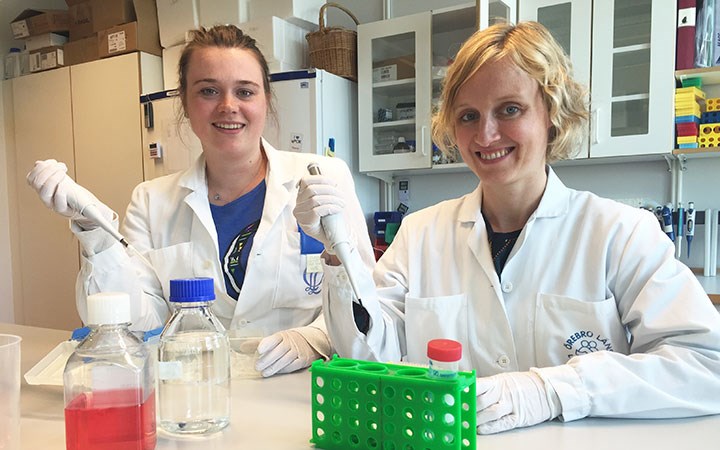Tablet prevents gluten from entering the small intestine

Julia König (right) is lead author of the study which shows that taking a tablet containing a specific enzyme prevents gluten from entering the small intestine. With the tablet, gluten-sensitive individuals may ingest small amounts of gluten without experiencing problems such as abdominal pain. PhD student Savanne Holster (left) has also worked on the study.
A tablet makes it possible for gluten-sensitive individuals to ingest small amounts of gluten without experiencing symptoms such as bloatedness, diarrhoea and abdominal pain. The tablet is a result of a study at Örebro University presented at a research conference in Chicago by Örebro researcher Julia König.
The encouraging results from the enzyme known as aspergillus niger-derived prolyl endoprotease (AN-PEP) were presented at Digestive Disease Week® (DDW) 2017, the largest international gathering of physicians, researchers and academics in the fields of gastroenterology, hepatology, endoscopy and gastrointestinal surgery.
"This substance allows gluten-sensitive patients to feel safer, for example, when they are out with friends at a restaurant and can't be sure whether something is 100 percent gluten-free," said Julia König, PhD, the study's lead author and post-doctoral research fellow at the School of Medical Sciences at University of Örebro, Sweden. "Since even small amounts of gluten can affect gluten-sensitive patients, this supplement can play an important role in addressing the residual gluten that is often the cause of uncomfortable symptoms."
First on a normal meal
Previous studies had shown that AN-PEP could break down gluten when it was intragastrically infused in a liquid meal through a feeding tube. This is the first study involving a normal meal: 18 self-reported gluten-sensitive patients ate a porridge that included two crumbled wheat cookies containing gluten. They also took either a high dose or low dose of AN-PEP, or a placebo. Researchers then measured gluten levels in the stomach and small intestine over the course of three hours.
The study found that AN-PEP, in both high and low doses, broke down gluten in both the stomach and the first part of the small intestine, or duodenum. In the stomach, gluten levels in both the high- and low-dose groups were 85 percent lower than in the placebo group. Once the food reached the duodenum, gluten levels were reduced by 81 percent in the high dose group and 87 percent in the low dose group versus placebo.
Not to eat pizza and pasta
"Studies show that even when following a gluten-free diet, unintentional gluten intake can still occur, depending on how strict a gluten-free dieter is," added Dr. König. "Our results suggest that this enzyme can potentially reduce the side effects that occur when gluten-sensitive individuals accidentally eat a little gluten. We are not suggesting that AN-PEP will give these individuals the ability to eat pizza or pasta, sources of large amounts of gluten, but it might make them feel better if they mistakenly ingest gluten."
Dr. König noted that her team did not test the enzyme on celiac disease patients, because even small amounts of gluten can cause long-term harm in these individuals. Because of that, she does not recommend celiac patients view this enzyme as a way to start eating any gluten.
